Game Review
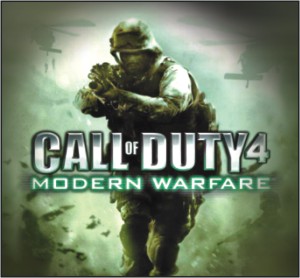
By Sadman Alvi
If there ever has been something overdone in games it surely has to be the WWII. The number of games based on the Second World War borders on the ludicrous side of too many. Especially, there has never been a lack of shooters based on the WWII scenario. The Call of Duty games, however, despite being just WWII shooters, have always had a distinct edge over the others and were simply better games. With good storyline, diverse and immersive gameplay from multiple perspectives and awesome level design, the games of the series have always provided an enjoyable experience for me. And now in the latest installment of the Call of Duty series, the developers have focused their attention to the modern times.
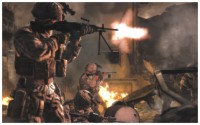 Inevitably, as is the case with all realistic modern shooters, you basically have to shoot a bunch of Russians and Arabs (the North Koreans take a break from threatening the fate of mankind in this game and are spared). But that's pretty much the only part of the game that's conventional. In the game you fight on the frontline in a Middle Eastern country to capture their firebrand dictator named Al Asad(the name of the country is never revealed, most likely to avoid diplomatic complications) as an US marine named Paul Jackson, and take part in covert missions in Russia to bring down an ultranationalist leader named Jahkaev as a British S.A.S. agent named John "Soap" MacTavish. This enables you to be a part of both of the main events that drive the game forward. There is also a special assassination mission taking place 15 years ago, where you have to play as Captain Price of the S.A.S.
Inevitably, as is the case with all realistic modern shooters, you basically have to shoot a bunch of Russians and Arabs (the North Koreans take a break from threatening the fate of mankind in this game and are spared). But that's pretty much the only part of the game that's conventional. In the game you fight on the frontline in a Middle Eastern country to capture their firebrand dictator named Al Asad(the name of the country is never revealed, most likely to avoid diplomatic complications) as an US marine named Paul Jackson, and take part in covert missions in Russia to bring down an ultranationalist leader named Jahkaev as a British S.A.S. agent named John "Soap" MacTavish. This enables you to be a part of both of the main events that drive the game forward. There is also a special assassination mission taking place 15 years ago, where you have to play as Captain Price of the S.A.S.
In all of the instances you have to fight as a member of a team. Your teammates fight beside you without you having to issue commands and do quite a good job at it. Their excellent A.I. makes you really feel as though you are part of a team. They will often yell to request for help, to indicate enemy positions and to warn about grenades. This can be very useful in the battlefield. Team work is the key word in the game, especially when playing as one of the elite S.A.S. commandoes. For instance, in one mission as you and another operative sneak through an area surrounded by enemies, both of you have to simultaneously take out two guys adjacent to each other in order to avoid the enemies being alarmed. And trust me, following orders, doing your part properly and getting the job done as a member of the team is much more satisfying than gunning down a horde of enemies by yourself like a super soldier and eventually saving the world on your own. But it's not only those on your side who are smart, the enemy A.I. is also awesome, they take cover, poke their head out to shoot and throw grenades to dish you out of your cover.
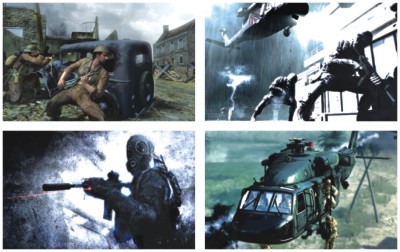
However, what makes this game truly awesome and unforgettable is the emotionally packed, ingenious and amazing story line full of twists and turns. Nowadays it's not particularly hard to find games with storylines better than most of the scripts from Hollywood, but it's very rarely that a game integrates the story with the gameplay so seamlessly and beautifully. In most games the story is just there because the gamer needs a reason to shoot/slice a bunch of people, and it's quite isolated from the gameplay; once the cut scene is over you simply get back to the game and do what you were doing earlier. But in this game even the gameplay is cinematic right from the start, and I was actually moved by the happenings. Like, when I was raiding a village in search of Al Asad, I wasn't cautiously going from building to building with my rifle raised because a little ticker on the left hand side of the screen told me to move to the next building, but because I was really trying to catch the guy (reminded me the raid for a certain high profile dictator, just coincidence?). The game is full of involving missions like this one and has enough jaw dropping scenes to keep you on your toes all the way to the end. In particular, the escalating climax in the middle of the game was unlike anything I have ever seen and just took my breath away. And the graphics, simply in one word is “stunning”.
The game isn't groundbreaking or revolutionary in any way, it's basically another addition to the Modern war FPS games, but just like all the other call of duty games it's way better than the rest of its type. And with the ingeniously created cinematic gaming experience, this game is a must have for anyone with a strong enough PC. So now I leave you with a few lines from the rap by Sgt. Griggs (one of the marines who fight beside you in the game…oh, and he is black, surprised? Didn't think so), that plays over the end credits.
Sgt. Griggs reporting for duty, roger
Some say this belong in the movie
But this is the 3rd installment in infinity ward shit
Don't swallow your jaws cause it's deep in its heart bitch


By Adnan M. S. Fakir
While moving around and chatting with many people for the “Celebrating Bangladesh Series,” (which has been pretty lifeless for a while) one of the main queries that I often resort to asking myself is about the history of Bangladesh; I am not talking about 1971, but beyond that… past 1947, past 1757 and even past 1576 to before Christ, and how Bangladesh gradually emerged from then. We have many such ancient relics in our exquisite country, and in order to comprehend them we need to be aware of our history. While as mundane as it may sound, it can also end up being appealing as many of our roots are engraved in this. Interestingly, our Bangladeshi blood most likely contains an assortment of not only Dravidian, Aryan, Turkish and Afghan blood, but also possibly Greek and Roman!
Bangladesh is pretty much a new state in an ancient land and many historians describe it as “a country challenged by contradictions." Frankly speaking, till 1947 when India and (East and West) Pakistan was formed, Bangladesh never was a distinct geographical entity nor a well-defined historical unit, which explains quite well why its history is not usually studied. In fact, it was pretty damn hard finding even a relatively proper account of it. The Bangladesh “region” in the ancient period was an integral part of mighty empires in northern India, and that is exactly how the history unfolds. Below is a rough account with references to major related events and some relics from the Dhaka and Rajshahi divisions.
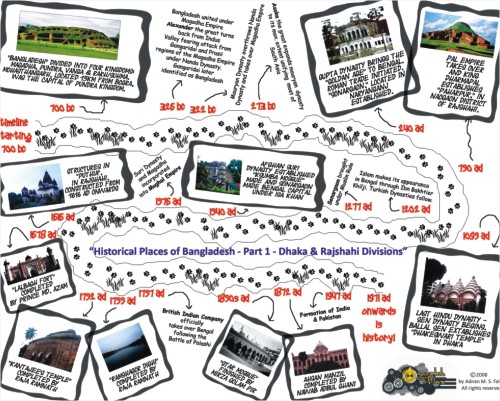
700 BC to 239 AD: Linking Buddha, Alexander and Asoka
A good point to start is probably at 700 BC, the approximate birth year of Mohasthangarh, the oldest historical site in Bangladesh. During that period, the Bangladesh region was roughly part of four kingdoms: the Pundra kingdom in the north, Vanga in the south, Rarh/Suhma in the east while the west was part of the great Magadha Empire, which also comprised of parts of India, Nepal and Pakistan. Mohasthangarh, located 13 km from Bogra, used to be the capital of the Pundra Kingdom.
Siddhartha Gautama Buddha was born in Kapilavastu of Kosala (present day Nepal), which was under the Magadha empire in 563 BD. Slowly, Magadha, under Nanda Dynasty, also included the rest of Bangladesh in its territory (except the Sundarbans) and it was during this period that Buddhism started to have its first impacts in the region, now Bangladesh. By 326 BC Alexander the Great had reached the borders of the Magadha Empire and also conquered a few of its principalities. As history depicts, Alexander turned back from the Indus Valley fearing a massive attack from Gangaridai and Prasii regions of the Magadha Empire along the bank of the Ganges. What is interesting about this is that Gangaridai has been identified as present day Bangladesh.
Mauryan Dynasty followed the Nanda Dynasty in 322 BC under Chandragupta Maurya and in 273 BC, Asoka the Great, a Mauryan king, extended the Magadha Empire territory to its maximum, fending off the troops that Alexander had left along the eastern borders. Although Asoka's impact is more recognised in present day India, he did greatly shape the state of Buddhism in Bangladesh, the influence of which can be best seen in Mohasthangarh.
240 AD to 1201 AD: the Kama Sutra, Roman Trade & last independent Hindu Dynasty
Gupta Dynasty eventually succeeded the Mauryans in 240 AD, and the time was known as the Golden Age. While science & literature flourished during this period with several schools and institutions established, Gupta dynasty is also famous for its controversial founding of the Kama Sutra, which may also partly be the reason why it's called the “Golden Age.” Ehmm! Anyways, trade with the Romans also initiated during the Gupta Dynasty and it is guessed that during this period the port city of Sonargaon, situated in present day Naryanganj, was also established.
Pal Dynasty followed the Golden Age in 750 AD and in 770 AD, the second king Dharmapal established Paharpur, a World Heritage site located in present day Naogaon of Rajshahi, the largest known Buddhist Monastery south of the Himalayas. In 1095 AD the Sen Dynasty took over which was the last independent Hindu Dynasty ruling over Bangladesh; notable structure of that period include the Dhakeswari temple, located southwest of Salimullah Hall of Dhaka University, which is currently the national temple of Dhaka.
1202 AD to 1575 AD: the Arrival of Islam - the Afghans & the Turks
Islam made its first appearance in Bengal on 1202 and Ibn Bakhtier Khilji, an Afghan, is lavishly credited for so in our famous poet Al Mahmud's book “Bakhtiyarer Ghora.” In the book Al Mahmud cites and depicts that Bakhtier advanced so rapidly that only 18 horsemen from his army could keep up, and whence they had entered Bangladesh they were mistaken for horse traders, allowing them to surprise the then Raja Lakshman Sen. Bakhtier was however killed in 1208 and a Turkish Dynasty followed during which Sonargaon was brought under Muslim rule in 1277.
The Muslim rulers of Bengal are known as the Delhi Sultanates as most of them ruled the region from Delhi. Eventually the Afghan Suri Dynasty came into the front in 1540 AD during which the famous Ksumba Mosque, located in the Manda Upazila of Naogaon Distrct, was built. Isa Khan was also one of the last famous kings of the Suri Dynasty during which Sonargaon, the port city, was made the Bengal capital.
1576 AD onwards: the steps towards Bangladesh
It was in 1576 that Bangladesh (and the Suri Empire) was defeated and incorporated into the Mughal Dynasty. History from then on is pretty well kept and as before I will not get the details as those are huge chapters and this article is already getting kind of humdrum and vast. Nonetheless, several spectacular relics were constructed during this period including the structures at Puthia (1616 onwards), the Lalbagh Fort by Prince Md. Azam (1678 AD), Kantajee's Temple by Raja Prannath (1752 AD), Ramshagor Dishi by Raja Ramnath (1755 AD) and so on.
Following the battle of Polashi in 1757 AD, the British Indian Company had officially taken over and we all know about 1947 when India and Pakistan had been separated following the progressed revolutions of Gandhi and Jinnah, which gave the first unique geographical shape to the Bangladesh. Relics from between this period include the Tara Masjid built by Mirza Golam Pir sometime along the 1850s, and Ahsan Manzil in 1872.
1971 (and a lot of other preceding events) followed, and the rest is pretty much recent history…

Reviewed by Gokhra
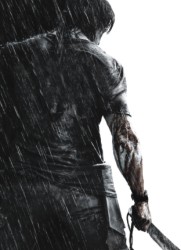 Title revival is hot business for the movie industry these days. Everybody and their sidekick is making a comeback as their best on-screen character. Call it nostalgia or just a lack of original idea, it is making money if nothing else. But that's not the one and only yardstick of success.
Title revival is hot business for the movie industry these days. Everybody and their sidekick is making a comeback as their best on-screen character. Call it nostalgia or just a lack of original idea, it is making money if nothing else. But that's not the one and only yardstick of success.
We have had the 'governator' reprising his role as the Terminator long after the movie was thought to be done and over with in “T2: Judgement Day”. Then we had Stallone coming back as Rocky and surprisingly it was a big hit. Now we have Harrison Ford coming back as Indie closely following on the heels of Rambo.
Stallone comes back as the thoroughly angry Vietnam Vet John Rambo. And despite being widely slated by the critics, it s a major hit with fans and regular viewers alike.
The plot:
Rambo is not about deep insightful views. It's about mayhem and things going boom. But there rises the question as to what more could possibly be done with it? Make things go boom in innovative perhaps?
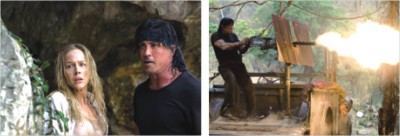
The setting is Burma thankfully leaving out the usual movie reference to Iraq. A group of religious do-gooders get caught up in the middle of a brutal civil war. With no hope in sight, a reverend turns to John Rambo who has long given up his soldiering ways and gone for handling snakes instead.
The reverend wants to hire mercenaries to "professionals" go get back his people from the war struck area. And Rambo is the man to guide them in. Of course, the hired help is made up of a group of extremely confident, arrogant and egotistical soldiers. And that means they also fail woefully. Who better to show them the way again than Rambo.
We also have a female protagonist in the form of an idealist named Sarah (Julie Benz) whom Rambo seems to be a little smitten with. And for her, he wil break into a heavily-fortified compound to save her and friends before they are tortured and killed and tortured again.
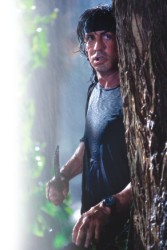 The verdict:
The verdict:
The movie is about action and classic at that. Rambo is a silent no-questions-asked sort of character who takes a single minded approach to getting the job done. And he does it so in spectacular style with bucket loads of the red stuff flying all around.
Rambo is so much fun because it doesn't provide any excuse. It's an age old battle between good and evil providing heroes just the way you want them. To heck with the 'professional' critics. If action is your cup of strong coffee then this movie delivers.
You may wonder how Stallone at 61 pulls it off. Apparently a lot of weight training got him back in shape. While you may need to suspend disbelief a little when you see him pulling off the kills, somehow, he actually makes it look possible.
